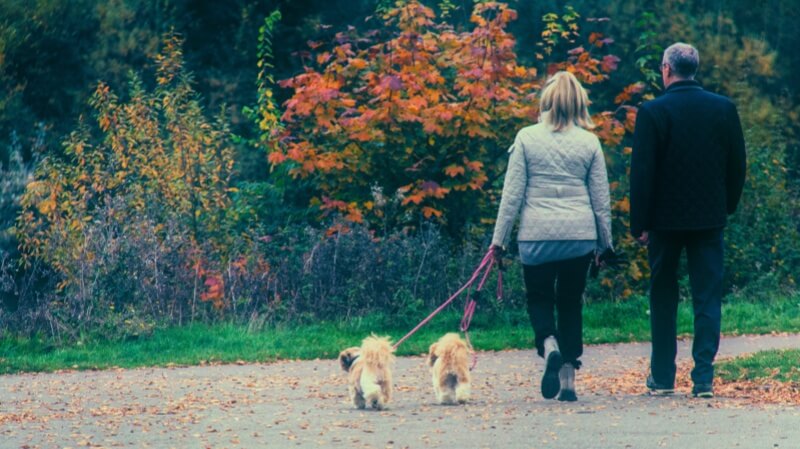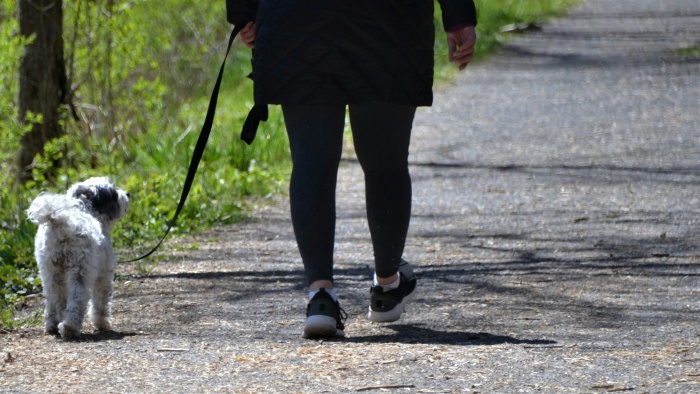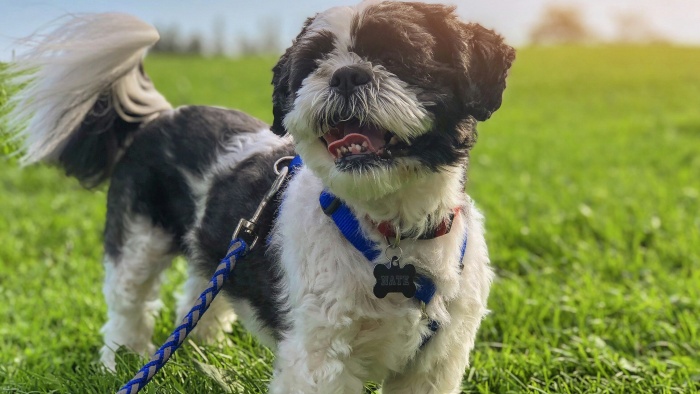When Should You Walk The Dog?

If you’ve just welcomed your new four-legged friend into your home, the question “when should you walk the dog?” might already be on your mind. The excitement of showing your puppy off to your loved ones, embarking on new journeys together, and enjoying endless walks and boundless affection is undeniable. Yet, it’s crucial to exercise patience.

Your puppy’s well-being, health, and safety must be your foremost concern. While socializing with them is essential for their confidence and familiarization with their surroundings, it’s important to proceed with caution to protect their health. This includes allowing their bones and joints to fully develop without exposing them to undue risk.
When is it safe for my puppy to explore outdoors?
In the initial stages of their life, puppies are exceedingly susceptible to harm, and premature outdoor adventures could expose them to serious illnesses. However, if your yard is secure and free from the presence of unvaccinated dogs, it’s safe to begin their housebreaking exercises outdoors, while ensuring vigilant supervision.
Veterinarians usually advise waiting for two weeks after the puppy’s second set of shots before venturing into public areas. This delay is beneficial for allowing the puppy to adjust to their new surroundings and for their innate immunity to develop.
Can my puppy go on walks after receiving its initial vaccine?
Before your puppy is fully vaccinated, it’s crucial to refrain from taking them on walks. Your veterinarian might permit you to bring your puppy outside as long as you hold them in your arms or a carrier, but they should never be placed on the ground.
During the interval before their second vaccine, utilize your home’s secure area to familiarize your puppy with wearing a collar. Initially, have them wear it for brief periods. Once they seem at ease, you can begin leash training in your backyard, preparing them for future walks outdoors.
Additionally, if you know people with sociable, vaccinated pets, consider organizing a playdate in your yard. This could serve as a valuable socializing opportunity for your puppy’s first interaction with another dog.
Puppy vaccination details: 💉
- The first vaccination is administered between 8-10 weeks old
- The second dose follows 2-4 weeks after the initial, around 12 weeks old
- Annual booster shots are recommended to maintain their immunity
These vaccines safeguard puppies from diseases like Parvovirus, Infectious Canine Hepatitis, Distemper, and Leptospirosis.
An extra vaccination is available for kennel cough prevention.

How do you introduce your puppy to their first walk?
Stepping out with your puppy for their initial outing is a significant event, marking an exciting phase in their development. Given the vastness of the outside world may seem daunting, it’s crucial to approach this experience with patience, understanding that progress may be modest at the outset.
Consider the following points before embarking on your puppy’s inaugural stroll:
- Is your puppy at ease wearing a collar? Utilize your time indoors to accustom them to a collar, ensuring they’re prepared for their first venture outside.
- Choosing a serene and tranquil location is advisable, be it your neighborhood street or a verdant spot in close proximity.
- Opt for brief jaunts initially to gradually enhance their stamina without subjecting them to excessive stimuli. As you both navigate through several short walks, you’ll likely notice an increase in their confidence.
- Steer clear of extremely hot or cold times of the day. Puppies are particularly vulnerable to temperature fluctuations, with a higher risk of overheating. Additionally, verify the ground’s temperature to avoid injuring your puppy’s paw pads if it’s overly warm.
- When possible, keep a relaxed yet short leash. A tense leash may induce stress and hinder your puppy’s ability to communicate effectively.
- Equipped with delectable treats, reward your puppy for displaying desirable behaviors. Whether it’s a courteous greeting to another person or dog, staying close to you, or seeking your assurance, reinforcing these actions will encourage their repetition, thereby boosting their confidence in outdoor settings.
- Expect plenty of pauses for sniffing, as puppies explore their surroundings using their senses of sight, smell, and hearing.
- Pay attention to their body language; signs such as lying down or panting may indicate they’re reaching their limit. It’s important to avoid pushing them too hard, both physically and mentally.
- The initial encounters with other dogs and people can be overwhelming for your puppy. They may appear apprehensive, so always check with other dog owners before allowing interactions, as dogs’ reactions can be unpredictable.
Lastly, remember to carry your puppy’s essentials, including waste bags and ample water for hydration. It’s also a legal obligation to have an ID tag on your puppy’s collar.

How much walking is right for my puppy?
A handy guideline suggests that puppies may walk for five minutes per month of age, starting from 8 weeks. Thus, a 2-month-old puppy could manage walks lasting about 10 minutes.
Bear in mind the breed of your puppy, as excessive exercise in larger or giant dog breeds might cause orthopaedic issues later in life. This risk stems from their rapid growth rate compared to smaller breeds, alongside a slower maturation process.
Consulting your veterinarian for tailored advice regarding your puppy’s exercise needs is always wise.
What are the consequences of excessive walking for my puppy?
Indeed, overexerting a puppy through too much walking can harm their musculoskeletal development, notably affecting the growth plates—areas of cartilage found at the ends of long bones.
Excessive exercise might lead to fatigue, as puppies tire easily, and in some cases, injuries, since their bodies are not fully matured. Should you suspect your puppy has strained themselves, a veterinary visit is advisable to ensure their well-being.
How can I exercise my puppy without walking?
Engaging your puppy in alternative forms of exercise, such as playing fetch with their preferred toy or allowing them to expend energy indoors, is beneficial. Puzzle toys or a kong filled with a delicious treat can also offer mental stimulation and keep them occupied.
Providing several exercise sessions throughout the day, interspersed with ample rest periods for sleep, is essential for your puppy’s health and development.
Conclusion
When should you walk the dog is a question that depends on various factors, such as the puppy’s vaccination schedule, their age, and specific breed characteristics.
It’s essential to prioritize their health and safety by waiting until they have received at least the initial vaccinations and consulting with a veterinarian for personalized advice.
Beginning with short walks in secure and quiet environments will help your puppy adapt to outdoor adventures while ensuring their physical and mental well-being.
As you gradually introduce them to the outside world, remember to observe their behavior and adjust the length and intensity of walks accordingly. This careful approach will lay a solid foundation for a lifetime of enjoyable walks and robust health for your beloved pet.
FAQs
What should I do if my puppy seems scared during their first walk?
If your puppy appears scared during their first walk, it’s important to remain calm and reassuring. Try to shorten the walk and focus on familiar, less intimidating environments. Gradually introduce new areas as your puppy becomes more comfortable and confident.
Can I carry my puppy in public places before they’re fully vaccinated?
Yes, carrying your puppy in public places before they’re fully vaccinated is a safe way to expose them to new sights, sounds, and smells without putting them at risk of contracting diseases from the ground. Just ensure they do not come into direct contact with other animals or unclean surfaces.
How do I know if my puppy is getting enough exercise?
Monitor your puppy for signs of healthy fatigue, such as a good appetite and a regular sleeping pattern. If they are restless or destructive, they may need more physical activity. However, always balance exercise with their age and physical capabilities to prevent overexertion.
What are some signs that my puppy is ready to go on longer walks?
Signs that your puppy is ready for longer walks include maintaining a good pace without showing signs of fatigue, showing curiosity and eagerness to explore, and consistently obeying commands even in new environments. Always increase walk durations gradually.
How do I safely introduce my puppy to other dogs during walks?
When introducing your puppy to other dogs, choose calm, friendly dogs that are known to be well-behaved around puppies. Always ask the other dog owner for permission before allowing any interactions, and keep both dogs on a short leash to maintain control over the situation. Monitor their body language closely for any signs of discomfort or aggression, and be ready to separate them gently if necessary.

